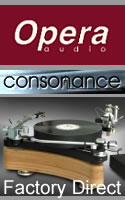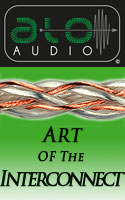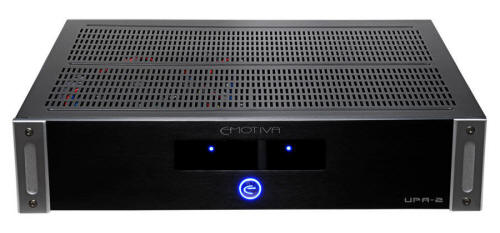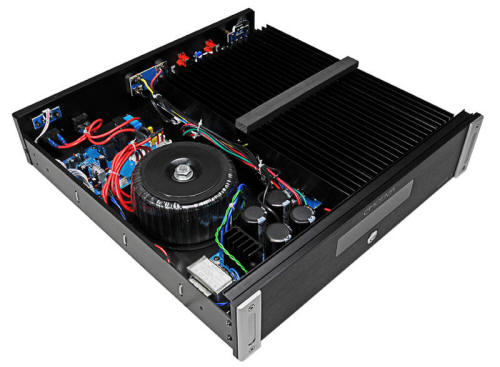|
|
You are reading the older HTML site
Positive Feedback
ISSUE
58
emotiva UPA-2 Amplifier as reviewed by Dan Dzuban
I remember hearing about Emotiva a few years back from my friend Dave Berman, who was CEO of Soliloquy Loudspeakers. He raved about not just their price vs. performance, but their performance altogether. That's, of course, the kind of equipment that interests me, so I spent some time reading about them on the web. It seems that they have quite an "underground" following. I say underground because Emotiva isn't quite a household name in audio, but its followers sure hold them in high regard. On one hand, I trust Dave's ears, but could the equipment still be worthy of all of that buzz? Or is it a case of a bunch of fanboy followers liking the equipment because it isn't a household name? The Emotiva website has some bold claims about the engineering, components, and build quality that goes into their equipment. Yet, it has some modest claims regarding the gear at hand—the two channel, 125 watt per channel UPA-2 amplifier. "Perfect for adding more power to A/V receivers or multiroom systems." That's not very ambitious sounding, nor encouraging for high-end types. But then again, sadly, those are the kind of uses that pay the bills within the audio market generally. So who is right? Is this no more than a solidly built amp to add to a Best Buy-grade A/V receiver? I will save you the suspense of having to skip to the end of the review for the answer (sort of). By Emotiva's own criteria of suitability for A/V receiver upgrades or multiroom uses, I would say that professionally the UPA-2 is a fail. Maybe I am clinging to my strategy of "non-intended uses" too tightly or maybe Emotiva just dramatically understated the potential of this amp, but it would be an absolute travesty to waste this amp on such uses. This is an excellent amplifier. I am sure folks can find crappy amps to add on to their crappy receivers, but the UPA-2 belongs in an overachieving True Factoring system. Now that we have dispensed with the pleasantries, let's dig into the details of why I hold it in such high regard. Preconceptions First of all, the amplifier is priced to sell as an A/V upgrade, but that pricing shouldn't define it. Emotiva is sold factory direct via their website. Like much equipment these days, it is built in China. Emotiva's prices are actually so low, admittedly, that my first thought was how could the stuff be any good at that price? Well, I should have known better! If you have Asian manufacturing, but sell direct to consumers without having retailers, reps., and distributors/importers in the mix, it is possible to price it this low. I would estimate that traditional manufacturing and retail channels would result in 4-5 times the prices that Emotiva is charging. Once you realize this, it should be no surprise that the gear should outperform other gear at the same price point. What Emotiva is giving up in name recognition, they are making up in consumer value. So from that standpoint, does this appear like a $2000 amplifier? Yes. You be the judge Overbuilt for its intended use, or just a good case of giving the consumer more than he paid for? I will let you decide. This is a solidly built, heavyweight amp with a 3/8" thick faceplate—kind of what you would expect if you paid that $2k I've mentioned. Unlike receivers at anywhere near this price point, the Emotiva is chock full of beefy, chunky discrete components, all neatly organized around some thick heat sinking and a big toroidal transformer. This is in contrast with the innards of receivers, which are chock full of tiny parts and tinny, old-school transformers. This comparison really shouldn't come as a surprise—this is a typical modus operandi for equipment with high-end aspirations—but not for $300 gear. Now I can't comment on parts quality per se, other than that I did not see any of the name brands parts that audiophiles like to see. But, that is another topic for another day—whether solid engineering or brand named parts are the bigger factor for sound quality. All else equal, I am sure you could get incremental improvements with better parts quality, but Emotiva may be a testament to the level of sound you can get with solid engineering and the right parts in the right places.
Intended uses I started out using the amp for its suggested purpose; I hooked it up to my Maggies via the line outputs from my Onkyo receiver instead of using the Onkyo's amplifier output. We audiophile types would say I used the Onkyo as a preamp to drive the Emotiva. It honestly didn't sound that different from the Onkyo, but maybe after more break in it might. But when I used my dedicated Parasound 1200 preamp as a, well, preamp, the Emotiva exploded—sonically that is. There is little point even discussing any comparison, because there really was no comparison. When the Parasound unleashed the Emotiva's potential, it went from sonic wallflower to sonic supermodel. I hate to use words like "unleashed," but that really is what happened. And it would be a crying shame for other folks who are using the Emotiva to "boost" the power of their receiver to never hear what I mean by unleashed. Now some of the more careful readers will have noticed "Parasound" and will want to know what role the Parasound preamp had here. Suffice it to say it had a huge role, but those details will be left to another review to follow shortly. Also, for a reality check, I was able to substitute the Emotiva for another amp that I was able to borrow—but only for a very short time. That comparison was very short—short enough to confirm what I heard from the Emotiva, but too short for me to want to seemingly throw it under the Emotiva bus in detail, so it shall remain anonymous. Fleeting warmth As a True Factoring devotee, I am aiming for a neutral sonic signature for reasons I have explained. So when the moment hits me that I realize that a component isn't necessarily warm and isn't necessarily sterile, I get a smile on my face. What I look for is "fleeting warmth," i.e., I measure success by hearing clear examples of warmth in a particular song, only to then hear other songs without warmth. In other words, the equipment is neutral, and it is getting out of the way and letting the music come through. Now admittedly, I am giving a slight nod to warmth here, because I would rather have that than clinical—but my goal still remains neutrality. New Order's "Ruined in a Day" put such a smile on my face. The song is a creative remix of Ennio Morricone's theme from The Good, the Bad, and the Ugly—which is one of my favorite soundtracks. Even Morricone's soundtrack itself sounded good. Songs came through in all of their scratchy mono-ness, yet were wholly listenable, and perhaps among as listenable as I have ever heard them. Folks think of the iconic main theme when they think of the soundtrack, but songs like "The Ecstasy Gold" and "The Trio" are the best of the genre and fully capable of sending chills down my spine through the Emotiva-amped system. Along with fleeting warmth, I did recognize what I would term a lack of resolution in harmonic textures. The amp wasn't edgy or thin, but it tended towards monotone in tonal color. Performers and instruments weren't as "fleshed out" as I have heard them. In this regard, the Amp reminded me of my $2500 Marsh Sound Design A400 of yor. I think Marsh and Emotiva use the same trick; reducing the tonal color palette a bit seems to make the soundstage more transparent and the images more pronounced. I don't think the decision is necessarily wrong, but it results in a deep, detailed soundstage for soundstaging freaks, at the cost of leaving tonal color freaks longing for more. Which camp you fall in will determine whether Emotiva's voicing decision excites or offends you.
This takes me to what I find to be the Emotiva's strength; in addition to achieving a neutral balance, I would cite its clarity, imaging and soundstaging. The amp seemed especially clear of any veiling or anomalies that would otherwise diminish a soundscape. Once again, I think Emotiva made a conscious decision in order to meet a certain price point, and for me this was a good decision. With some of my soundstaging standards, the Emotiva did very well. For example, Living Color's Nothingness (from Stain – Sony 1993) presented its usual massive soundstage, but with the sense of a "bubble of sound" with distinct instruments in different places, anchored by an extremely alive-sounding singing performance by Corey Glover. Granted, I have heard amps with more resolution, clarity, a bigger soundstage, AND that missing tonal color, but a bad amp simply can't do what this amp did for this recording. It is also interesting to note that I added a Lexicon MC8 preamp into my system during the review. Prior to the Lexicon, I felt that the Emotiva had great soundstaging and layering, but its images were a bit two-dimensional. It turns out that this was not due to the Emotiva. The Lexicon allowed the Emotiva to shine even brighter; now there was very little I could criticize about its soundstaging or imaging—I could "see" as deep and wide into a soundstage as I have ever "seen," and the individual images were not at all flat as they sometimes tended to be through my Parasound preamp. On one hand, you would expect an $800 preamp to be bested by an $8000 preamp, but on the other, you would expect a $300 amp to be exposed, rather than pick up its game when paired with an $8000 preamp. Caveats Caveats? Of course there are caveats. First of all, the Magnepans that I am currently using are akin to mini monitors, and have diminishing bass below 200Hz. I am using a sub to hit the very lowest bass, and there is a gap where I am otherwise missing bass energy. I am squarely blaming the Maggies in this regard, but the fact remains that I cannot assess the UPA-2's deep bass performance because these speakers cannot reproduce it. So, it kind of gets a pass this time around, and I will have to comment on its bass capabilities when I have in-house speakers that actually are capable of low bass. In the meantime, I am giving the amp the benefit of the doubt, but must reserve some judgment. Tying it all together with some true factoring If you read closely, you may have noted some enthusiasm in my review…. That is because it is hard to find a $300 amp as overachieving as this one. I couldn't really find any fault in anything it did. On the contrary, when paired with inexpensive components it sounded fantastic. When paired with kilobuck components, it didn't fall on its face, but rather stepped up. In that regard, it passed possibly the most stringent of logical tests; if this was a bad amp, it was logically impossible for me to be getting as good of sound as I was getting, regardless of how good the associated components are. In our non-True Factoring world, most manufacturers try to balance the prices of their electronics with what you would spend on other components and speakers, but here we have anomaly. On its merits, the Emotiva UPA-2 is objectively a fine amp, but within the context of True Factoring, it is an ideal amp. Once again, it is neutral without being sterile or clinical. Its power output is likely enough for most users in most scenarios. It is solidly built, with a good measure of gratuitous aesthetics thrown in without being needlessly lavish. If you could live without several hundred watts, extra sonic warmth, or half-inch faceplates, and would rather spend your money on speakers, this is the amp for you. Please just don't hook it up to a cheapo receiver and hope to get the most out of it. Give it the respect it deserves by pairing it with quality-associated equipment and you will have gotten perhaps two thousand dollars worth of amplification for $300. What more could you ask for? I for one couldn't ask for more—except that I may ask for more from Emotiva's new monoblock version of the UPA-2... Highly recommended. Dan Dzuban
UPA-2 Amplifier
Emotiva
|








